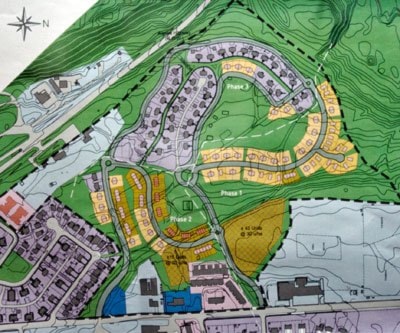Takhini North residents have had enough.
After participating in a six-month planning process that could see lot development in the subdivision grow to 277 units from 82, residents are balking at a city pitch for still more lots.
The city has suggested putting more lots in the area to balance its development costs. Under the existing plan, the city expects to lose $1.5 million.
When that plan was presented earlier this week, it looked as if residents were willing to accept the addition of 195 units in the neighbourhood, said Mark O’Brien, president of the Takhini North Community Association.
But, when officials said the conclusion of the charette was just the beginning of development talks — that it must be expanded to cut the city’s losses — residents lost confidence in the city plan, he said.
“The plan that was presented was pretty true to what came out of the charrette, and that’s what the residents are willing to get behind, it seems, which is actually quite a high density to begin with,” said O’Brien.
“To put in this high density, I think we’re reaching a critical mass in terms of what this neighbourhood can support and that’s definitely what the residents are feeling.”
Residents would like to see the city explore options, such as applying for territorial and/or federal funding, or dipping into city reserves, he said.
The three-phase plan was presented at the conclusion of the Takhini North charrette at the Mt. McIntyre Recreation Centre Wednesday night by city consultant Kobayashi and Zedda Architects Ltd.
The first phase suggests a mixture of single-family homes, duplexes and a large multi-family plot in the green area to the northeast of the existing 41-duplex neighbourhood. It is expected to make $400,000, according to the city.
Phase two is a mixture of duplexes and smaller multi-family lots near the broomball court to the east of existing homes. It is expected to loose $600,000.
Phase three consists of adding a few duplexes to the existing neighbourhood and overhauling the decrepit water and sewer system that was built in the 1940s.
Phase three, which includes more than $2 million in funding from the Municipal Rural Infrastructure Fund, is expected to loose $1.3 million, according to the city.
The Municipal Rural Infrastructure Fund is a one-third federal, one-third municipal and one-third territorial funding program for infrastructure projects.
Residents were presented a variety of options, including more units, because the project cannot lose money, said Mike Gau, city planning manager.
The residents’ plan would earn the city $12 million in revenue and cost them $13.5 million to build, a prospect that is not feasible for city hall, he said.
“Phase two falls short on cost recovery and that’s all the infill and phase one makes a little bit of profit and they nearly balance out.
“It’s phase three, the existing residences plus the additional five units, that falls substantially short.
“What we need to do, and council says, is we need to balance this. We can’t lose money on this.”
Residents were presented with a number of options to build on their charrette vision, according to the Power Point presentation delivered by city planners.
Option one is to increase the selling price of lots currently pegged at $70,000 for a single-family, $100,000 for a duplex, $160,000 for a four-plex, and $210,000 for a six-plex lot.
Option two proposes changing the services provided to multi-family lots to one service per lot, as opposed to one service per unit, which is estimated to save $500,000.
Option three would move new units as close to existing and new infrastructure as possible to save money.
Option four would alter the type of housing in the plan in an attempt to increase revenue.
Option five suggests adding more units in different areas of the development.
Option six is an application for more funding, according to the city.
An appraiser will be hired to assess the potential lots. The solution will probably involve a combination of options, said Gau.
The requirements for 100 per cent cost recovery on development in Takhini North is unanimously supported by council, said Mayor Bev Buckway on Thursday.
“We want to make sure when we develop an area that people from other areas of town aren’t paying for it.
“It’s pretty clear that council gave the direction of what we want to see, and council is united on that,” she said.
The city is looking to follow a sustainable path, which includes infilling existing neighbourhoods to avoid cutting into green areas, and will continue to follow that path in the face of opposition, said Buckway.
“We know with any new concept, it takes time for acceptance.
“There’s always going to be some opposition.”
The three-phase development of Takhini North represents the first time the city has planned, developed and sold lots, said city manager Dennis Shewfelt.
“To the best of my knowledge, the city has never undertaken land development of this nature — it’s always been done in participation with the territorial government,” he said last week.
“We did participate as a contributor to land in Takhini West, but we did not undertake the whole project, which was done by Public Works Canada.”
The staged approach is being used because the city needs to sell the lots as quickly as possible — it lacks the money to fund development and hold onto the lots for a long period of time, said Shewfelt.
“Municipal governments are not risk takers.”
